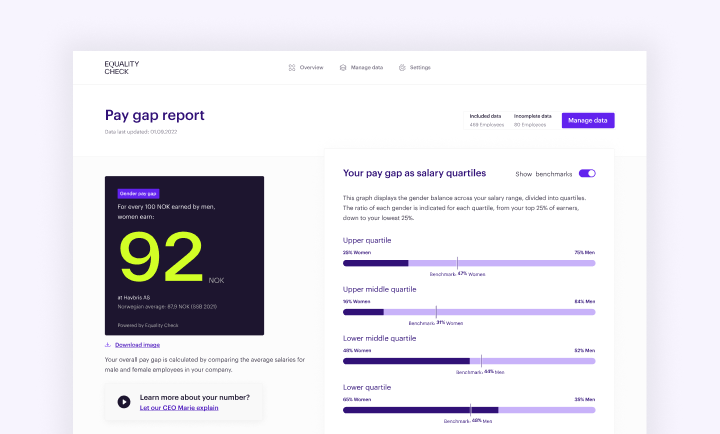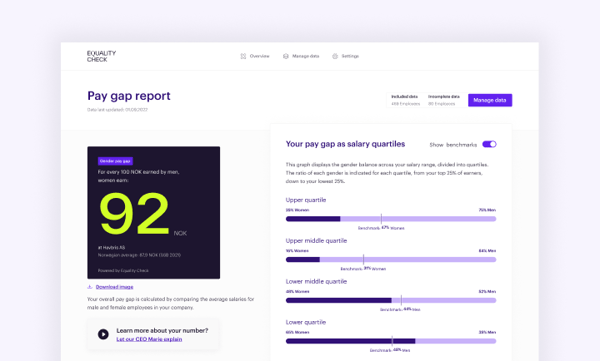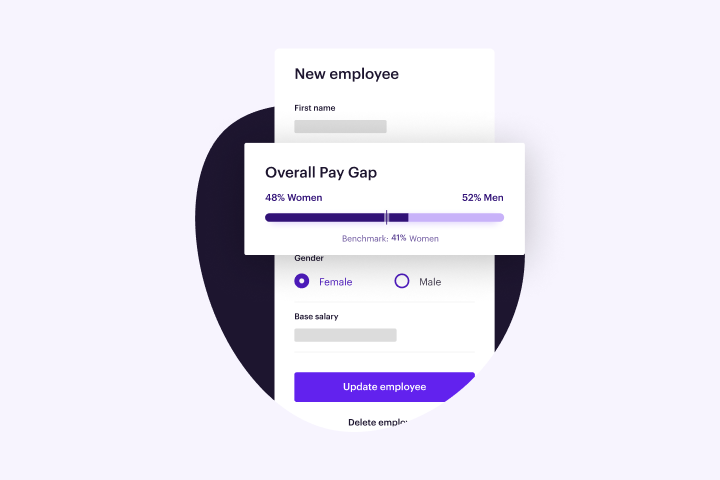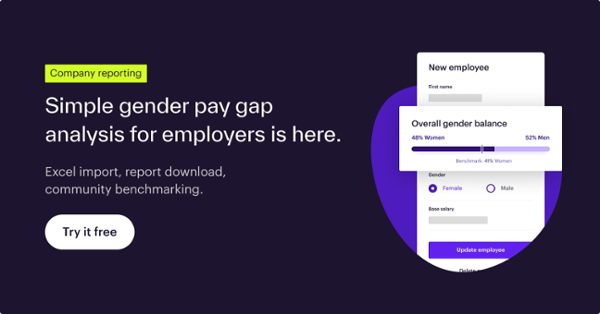In our experience, companies can get distracted or delayed by spending a lot of time discussing what they can and should measure when it comes to workplace DEI. However, equal pay is universally recognised as a key component of any workplace DEI strategy, which makes it a fairly good place for any company to start.
There a couple of important reasons that make sensible place to start for many organisations:
It’s concrete and measurable
+ It’s measuring real-world impact (pay is a real-world consequence for every employee)
+ It can be repeated to check progress
It relies on objective, structural data
+ It’s factual
+ It includes data for your whole organisation (salary and data)
+ It indicates overall patterns and biases
Why companies can often struggle with gender pay gap analysis
Undertaking pay gap analysis can seem like a large, resource-heavy task, requiring specialist knowledge and data. While most of us can agree equal pay is a good thing to aim for, many companies haven’t actually crunched the numbers to see if they have a pay gap. So conversations and approaches to pay equity are usually anchored by assumptions and intentions, rather than evidence-based.
But it doesn't have to be that way.
All companies actually have the raw data needed to get started with impactful pay gap analysis and generate clear, meaningful numbers. But you also need to do something with that data.
As a starting point, we can break the requirements for doing pay gap analysis into two related capabilities:
i) Data processing
What data to collect and analyse. What types of analysis to perform with the data.
ii) Expertise & analysis
How to understand the results and put the numbers into context.
Introducing gender pay gap analysis by Equality Check
We’re super excited to launch our this tool to help companies quickly get started with pay gap analysis and kickstart their workplace DEI strategy. It's completely free, and helps provide HR teams and senior business leaders with instant insights into gender pay gaps in their organisation, using the data you already have.
How it works:
1. Sign up with your company email
Anyone in your company can sign up, but you should have access to your company’s employee data, or be able to collaborate with a colleague that does.
2. Complete your company profile
Tell us more a little bit about your company you want to This contributes to enriching our community benchmarking data. We take this anonymous data and aggregate it to provide enriched performance benchmarks for our users.
It’s super easy to add the right data, and all your data is private and secure.
-
Download the Excel template from the Manage data tab
-
Add the required salary and legal gender data
-
Upload the completed file
4. Get your results
There’s no fiddly formulas or calculations for you to set up or implement. You just add the data and we do the rest.
- Simply hit View report to get your results
- Check your results on the report page and download the report to share it with your management team and board to discuss the results
→Try it now. Sign up for free.
What's included in the finished report?

The first thing to take a look at is the numbers. There are two main calculations provided in the report:
i) «Your number» indicates your overall gender pay gap: This number is calculated as a monetary value, indicating that for every 100 NOK your male employees earn, your female employees earn XXXNOK:
- This what we refer to as «Your number»
- Ideally this figure should be as close to 100 as possible (so that female employees earn 100NOK for every 100NOK earned by male employees)
- In reality, statistically most Norwegian employers will have a number below 100, as the national gender pay gap in Norway is 87 (SSB).
ii) Your pay gap as quartiles w/ community benchmarking: This graph displays your total pay scale, distributed as quartiles:
- The upper quartile represents the top earning 25% of employees, down to the lower quartile with the lowest earning 25% of employees.
- The graph also displays the gender balance within each pay quartile
- Optional - include community benchmarking in the graph to anonymously compare your results to the average company performance of the Equality Check community
Read our guide: What's your number? Everything you need to know about gender pay gap analysis
Report insights:
iiii) Summary: our report includes a written summary, with an explanation of what the results indicate about your gender pay gap.
iiv) Report download: Download the report as a presentation slide to share in your management group or with other stakeholders in order to facilitate internal discussions based on evidence instead of assumptions.
iv) Download your number: Download your overall pay gap number as an image file to share wherever you like. #KnowYourNumber.
- This is to help encourage employers to get more comfortable with pay transparency.
- Transparency builds trust with your employees and contributes to wider changes in the market beyond your organisation.
Unsure about sharing your number? All Norwegian companies with 50 employees are now required annually to publish a public report that includes an extended pay gap analysis.
Learn more about our ARP reporting tool for Norwegian employers here.
What else should I know?
Our pay gap tool is free for any company to use, and you can update your analysis whenever you like. Pay gaps are not a fixed destination, since the figures will naturally change as your workforce changes.
Using the tool can also help you to speed up your 2022 ARP reporting process. You can upgrade your free pay gap tool to Equality Check’s Compliance plan at any point to help reduce your compliance team’s reporting cycle. Our customers have already cut their reporting cycle by up 40% compared to not using our ARP solution.
- Tags:
- Product


